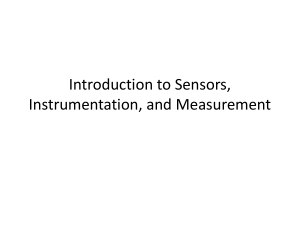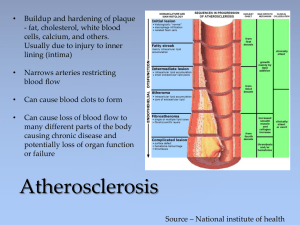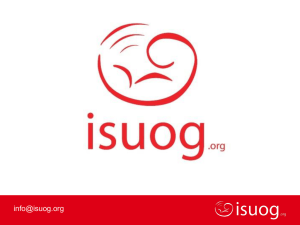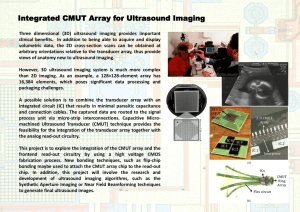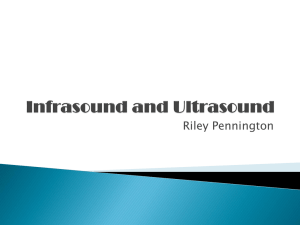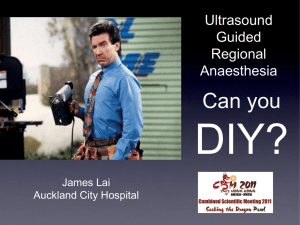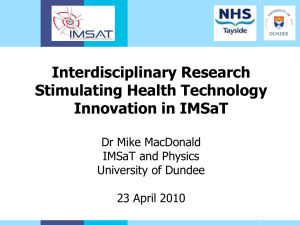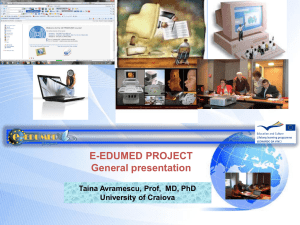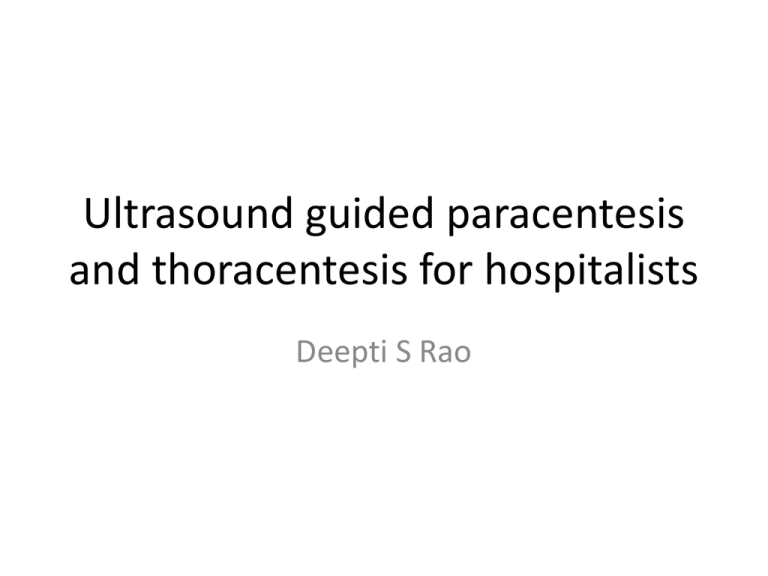
Ultrasound guided paracentesis
and thoracentesis for hospitalists
Deepti S Rao
Thanks
• Jason Cohen
• Michel Boivin
Objectives
After this session you should be able to:
1. Explain the rationale behind using ultrasound
in thoracentesis and paracentesis
2. Understand the objectives, outcomes and
activities proposed in my research project
3. Discuss the feasability of doing this project in
this group of hospitalists.
Ultrasound in procedures
• Central lines
– Lots of literature including increased patient
safety
• Thoracentesis/Paracentesis
– Not much literature
Ultrasound in thoracentesis
• Risk of complications up to 19%
• Grogan et al.
Archiv Int med, 1990
– 0% vs 29% reduction in pneumothorax when
ultrasound used for needle placement
• Raptopoulos et al.
Am Journ Roent, 1991.
– 3% vs 18%
– Irregardless of size of effusion, whether
thoracentesis was diagnostic or therapeutic, and
whether tap was dry.
Ultrasound in thoracentesis
ARCH INTERN MED/VOL 170 (NO. 4), FEB 22, 2010
•
Table 3. Unadjusted Odds Ratios for Pneumothorax by Procedural or Patient Factor (Direct Comparisons)
•
•
Variable
for Pneumothorax
•
•
•
•
•
•
•
Procedural Factors
Ultrasonography vs no ultrasonography
Experienced operator vs inexperienced
Therapeutic thoracentesis vs diagnostic
Larger needle or catheter vs small needle
2 Needle passes vs 1 pass
Follow-up thoracentesis vs initial
•
•
•
Periprocedural Factors
Aspiration of air vs none
Periprocedural symptoms vs none
•
•
•
•
•
•
•
Patient Factors
Large effusion size vs small
Male vs female sex
ICU inpatient location vs non-ICU inpatient
Non-ICU inpatient location vs outpatient
Mechanical ventilation vs not
Loculated pleural effusion vs nonloculated
•
•
Abbreviation: ICU, intensive care unit.
Only studies that reported results for both the presence and absence of a variable.
No. of Studies
6
4
12
7
3
3
2
3
7
3
3
2
2
3
No. of Patients With(Without) Variable Odds Ratio (95% Confidence Interval)
654 (1026)
308 (622)
1048 (1323)
700 (1178)
145 (580)
377 (993)
19 (661)
57 (1504)
758 (697)
272 (220)
142 (620)
213 (448)
100 (589)
106 (377)
0.3 (0.2-0.7)
0.7 (0.2-2.3)
2.6 (1.8-3.8)
2.5 (1.1-6.0)
2.5 (0.3-20.1)
1.1 (0.3-3.6)
104.0 (2.0-5355.0)
26.6 (2.7-262.5)
1.3 (0.8-1.9)
0.8 (0.3-1.7)
0.9 (0.4-1.8)
1.0 (0.5-2.0)
4.0 (0.95-16.8)
0.7 (0.3-1.7)
Ultrasound in thoracentesis
• “X marks the spot” after a delay not
associated in a reduction in pneumothorax
rate
–
Raptopoulos et al. Am J of Roent, 1991
Ultrasound in thoracentesis
• Failed thoracentesis
– 58% of clinically attempted dry taps had needle
insertion sites below the diaphragm
– Fluid can be successfully obtained in up to 88% of
patients who had failed clinically directed
thoracentesis
– Ultrasound increased rate of accurate site
selection 26% and decreased number of
dangerous needle insertions by 10%
(Weingardt, J Clin Ultra, 1994)
(Kopman, Chest, 2006.)
(Diacon, Chest 2003)
Ultrasound in thoracentesis
• In summary, the complication rate for
thoracentesis is high and ultrasound can
decrease that risk
Ultrasound in paracentesis
• Complications low (up to 2.7%)
–
Runyon, Arch Int Med, 1986
• Ultrasound may have a role in identifying
smaller pockets of fluid
– Physical exam can fail to find small amounts of
fluid or the most easily accessible pocket of fluid
– Ultrasound can detect pockets of fluid as small as
100cc
Ultrasound in paracentesis
• Ultrasound decreased the number of
unsuccessful attempts by demonstrating
which patients did not have sufficient ascites
to tap
–
Nazeer, etal. American Journal of Emergency Medicine, 2005.
So why do we want to do this?
• Patient safety
• Patient comfort (increased success in
performing)
• Resident learning and comfort
• Basis for eventual simulation based procedural
training
Resident comfort
Huang etal, The American Journal of Med, 2006
•
•
Table 3 Lack of comfort, by procedure
Lack of comfort with
All n 527
•
•
•
•
•
•
•
•
•
•
•
•
•
•
•
•
•
•
•
•
•
•
•
Indications and
contraindications, n (%)
Obtaining consent, n (%)
Anatomy, n (%)
Equipment, n (%)
Sterile technique, n (%)
Patient positioning, n (%)
Interpreting the results, n
(%)
11 (2.1%)
10 (1.9%)
28 (5.3%)
45 (8.5%)
7 (1.3%)
14 (2.7%)
Central line n 268
Lumbar puncture n 95
6 (2.2%)
5 (1.9%)
19 (7.1%)
19 (7.1%)
6 (2.2%)
6 (2.2%)
25 (4.7%)
16 (6.0%)
5/206 (2.4%)
3/89 (3.4%)
Paracentesis n 81
0 (0.0%)
2 (2.1%)
3 (3.2%)
5 (5.3%)
0 (0.0%)
4 (4.2%)
2 (2.1%)
Thoracentesis n 93 Pvalue*
0 (0.0%)
2 (2.5%)
1 (1.2%)
10 (12.3%)
1 (1.2%)
2 (2.5%)
5 (6.0%)
1 (1.2%)
5 (6.0%)
11 (13.3%)
0 (0.0%)
2 (2.4%)
3 (3.7%)
.017
.935
.040
.001
.494
.191
4 (4.8%)
.493
2/65 (3.1%)
.884
Being supervised, n/total
(%)†
0/27 (0.0%)
0/25 (0.0%)
Being unsupervised,
n/total (%)‡
119/321 (37.1%)
70/179 (39.1%)
23/68 (33.8%)
14/56 (25.0%)
12/18 (66.7%) .001
Managing complications,
n (%)
186 (35.3%)
87 (32.5%)
32 (33.7%)
28 (34.6%)
39 (47.0%) .003
Mean number of aspects
with lack of comfort, n
(SD, range)
0.85 (1.1, 0-8)
0.88 (1.2, 0-8)
0.75 (0.1, 0-4)
0.75 (1.0, 0-4)
0.98 (1.1, 0-6)
Thoracentesis –
Iatrogenic pneumothorax
• AHRQ Healthcare Cost & Utilization Project,
Nationwide Inpatient Sample database,
2000
• 7.45 million hospital d/c abstracts
• 994 short-term acute care hospitals
• 28 states
• JMH: July 2007 through June 2008
• Procedure team: July 2007 through June
2008
Number
Incidence Rate
National
n/a
2.68%
JMH
286
5.94%
Procedure team
89
1.12%*
15
Healthcare toll per episode
• 4 – 7 excess days in hospital length of stay
• $17,000 - $45,000 in excess cost
• 1% - 14% excess mortality
16
In summary
• Ultrasound decreases complication rates in
thoracentesis and may reduce unnecessary
procedures in paracentesis.
• This can reduce risk to our patients.
• This is a skill our residents should have
exposure to.
Curricula for teaching ultrasound
• Didactics
– Ultrasound physics
– Machine usage
– Indications
– Anatomy
• Supervised scanning
– Hand on hand
Judging competency
• Multiple choice testing
• Observed scanning
– 5-10 scans
ACEP: 3-4 hours didactics, 2-4 hours supervised
scanning
Research question
• Can a multi-part learning curriculum aimed at
inpatient medicine attendings increase the
competency of internal medicine physicians in
performing ultrasound guided paracentesis
and thoracentesis? And will this increased
competency lead to an increased use of
ultrasound for these procedures on the
medicine wards?
Secondary objectives
• Will this increase resident exposure/teaching
to ultrasound
• Will this decrease complication rates
Outcomes
Outcome
Measure
Learning activities
Competence in ultrasound guided para/thora
Pre- and post-multiple choice test on ultrasound
technology/anatomy
Direct observation of working machine and id fluid
time 0, 1 month and 1 year
Increased use of ultrasound on the wards
Monthly questionnaire of attendings
Chart review
Increased teaching/exposure of residents to ultrasound
Monthly questionnaire of attendings
Pre- and post- tests of residents on ward rotations
Decrease in complications
Chart reviews pre and post intervention.
Didactic sessions/ online training
Hands on trainings
Timeline
Timeline
August 2011
Attend resident Thursday school sessions—Rao
Start attending scheduled scanning session with Boivin—Rao
September 2011
Work with medical student to obtain HRRC approval and obtain medical record numbers and start
chart reviews for complication rates
Review Didactic sessions available—lecture and online
Organize didactic sessions/testing around didactic sessions
Begin working on questionnaires
Fourth quarter 2011
Start scheduling supervised scanning sessions
Continue with chart reviews
January 2012
Start testing physicians with direct observation of scanning and continue
Start monthly questionnaires of ultrasound on wards for attendings and residents
January 2013
End of surveys/daya analysis
Next steps
• What do you think
• Credentialing
• Billing and Coding

![Jiye Jin-2014[1].3.17](http://s2.studylib.net/store/data/005485437_1-38483f116d2f44a767f9ba4fa894c894-300x300.png)
